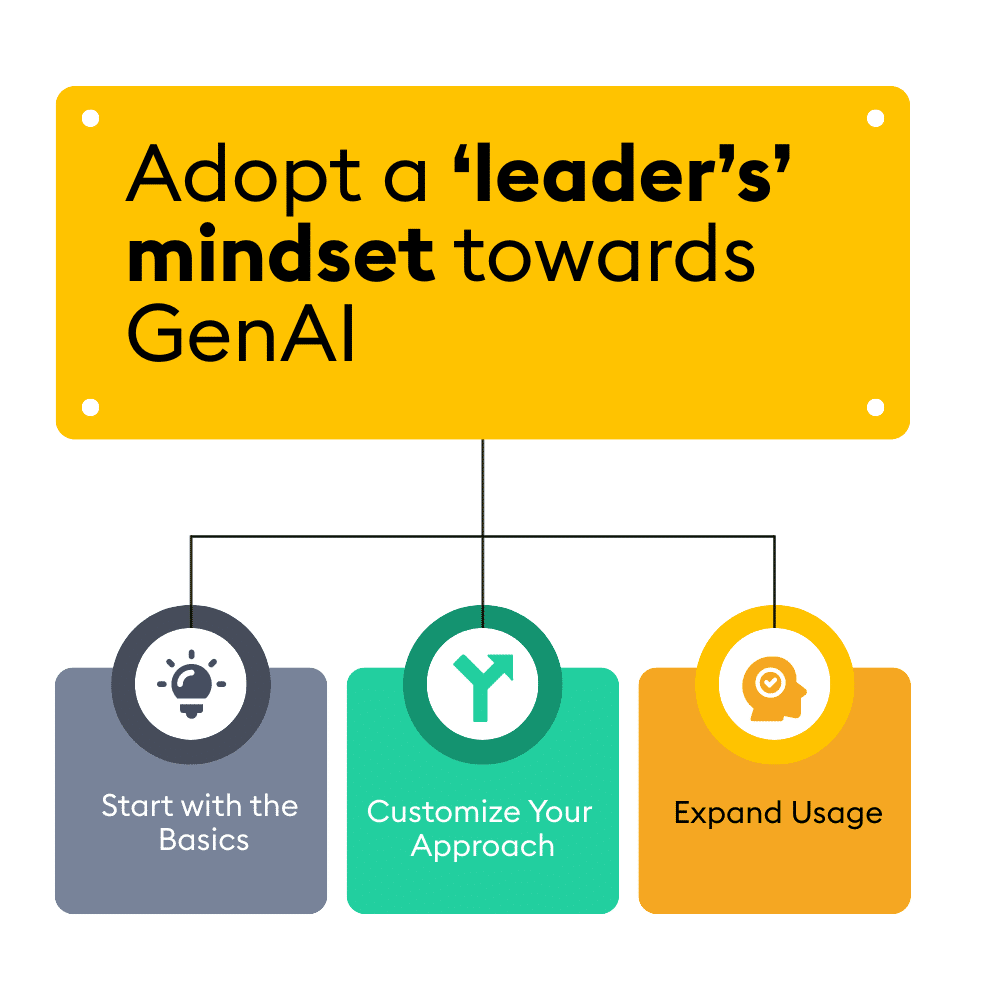Over the past ten months, some GenAI leaders have clearly distinguished themselves, creating substantial returns on investment and setting new benchmarks in their respective industries.
A new McKinsey & Company leadership survey highlights the impressive gains achieved by high-performing companies through the strategic use of GenAI. These companies can now attribute as much as 20% of their EBIT (earnings before income and taxes) to GenAI applications, with 65% of organizations employing these technologies regularly–twice as many as ten months ago.
But what differentiates these GenAI high performers from their counterparts?
In this blog, I’ll explore the key practices that separate successful companies from the rest and discuss several strategies that leaders are adopting to effectively implement and operationalize GenAI to drive meaningful business value.
Adopting a leaders’ mindset toward GenAI
A notable commonality among high-performing GenAI companies is their robust foundation in more traditional AI. These leaders not only have well-established systems designed to extract insights, detect patterns, and support decision-making but also report deriving over 20% of their EBIT from such non-generative systems. The survey suggests that success with traditional AI forms a strong basis for excelling with GenAI, with high performers also reporting over 10% of EBIT attributed directly to GenAI.
Their approach to GenAI also sets leaders apart. Companies at the forefront are more likely to develop proprietary AI models, seek unconventional data sources, and engage legal teams early in the process, unlike their counterparts who often rely on generic, out-of-the-box AI solutions.
Leading firms are also more likely to utilize GenAI more extensively across various departments. Not just in IT, sales, and marketing, but also in areas like risk management, legal, compliance, strategy, finance, supply chain, and inventory management.
Here’s how you can adopt a ‘leader’s’ mindset towards GenAI:

- Start with the Basics: Get to grips with traditional AI to build a foundational understanding of the value it can bring to your business. This will allow you to build a strong platform and business case for adopting GenAI.
- Customize Your Approach: Use the understanding of the value gained through analytical AI use cases to tailor models to fit your business requirements. Work with partners and platforms that help you customize optimized solutions (like KDB.AI, OpenAI GPT-4, Azure Cognitive Services, etc.) rather than relying on generic, out-the-box alternatives
- Expand Usage: Encourage different departments—beyond just IT, sales and marketing—to explore how GenAI can benefit their operations. GenAI isn’t just a time saving and efficiency tool. It can be used for significant value-driving applications throughout your business.
Leaders build AI factories
High performers are more likely than others to report experiencing challenges with their operating models, such as implementing agile ways of working and effective sprint performance management. High performers have a systematic approach, building what Marco Iansiti and Karim R. Lakhani (the authors of ‘Competing in the age of AI’) call an “AI Factory”.
An AI Factory systematizes the culture, processes, and tools required to apply AI. It can be summarized in the following stages:
As the diagram above suggests, the success of an AI Factory is reliant on the data feeding it.
Data is a top priority for organizations building their GenAI initiatives. AI-ready data needs to be well-structured, clean, and annotated to ensure accuracy and efficiency in GenAI applications. According to the McKinsey survey, 70% of leaders say they’ve experienced significant hurdles with data–far and away the top challenge faced by high performers (risk, at 48%, is a distant second-place challenge).
These data challenges are many, including:
- Establishing robust data governance: Define clear protocols for data usage and integration
- Enhancing data integration: Streamline the incorporation of new data into AI models for quicker, more effective results
- Addressing data scarcity: Develop strategies to augment training datasets to improve model accuracy
By overcoming these challenges, leaders can reimagine how they process data, designing modern data pipelines as the first step in forming their AI factory:
- Modernized data pipelines: These facilitate the collection and processing of new forms of data, especially unstructured data such as conversations with customers and sales prospects, images, and video. These are pivotal for training more sophisticated AI models.
- Algorithm development: Fed by the data pipelines, this is where AI engineers and analysts work together to invent, fine-tune, and train new models, customize off-the-shelf models, or, in some cases, use what already works. Again, high performers are more likely to customize or build entirely new AI models than laggards, who tend to use off-the-shelf algorithms without customization.
- Rigorous experimentation: Experimentation is how high performers establish protocols to assess and mitigate AI risks and biases. This involves including legal and compliance teams early in the development process to evaluate privacy, regulatory, or IP concerns.
By adopting an “AI factory” mindset and combining it with a highly performant data analytics tech stack, you can innovate faster, foster continuous improvement, and manage risks effectively.
Learning from high performers
The high-performing GenAI companies have begun to separate from the pack. They’re moving beyond pilots to drive significant business outcomes. But it’s still early – just 5% of over 800 respondents are in the lead, and it’s not too late to catch up.
To become a leader:
- Start with a strong foundation in traditional AI
- Engage more business functions
- Address data challenges early and systematically
- Adopt an “AI Factory” develop proprietary models
- Reimagine data processes to build a robust AI infrastructure
Apply these lessons to innovate faster, foster innovation, and manage risks, and you’ll be in the lead pack in no time at all.
Read more about what it takes to set up an AI factory in this blog: AI Factory 101.





